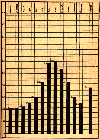NEONATOLOGY ON THE WEB
The Nursling
By Pierre Budin, Professor of Obstetrics, University of Paris; Director
of the Clinique Tarnier; Member of the Academy of Medicine, Paris, France. Authorized
translation by William J. Maloney, M.B., Ch. B., 1907.
Appendix X
Infantile Mortality
Balestre and Giletta de Saint Joseph (of Nice) compiled Statistics
of Paris and the towns of France which have more than 30,000
inhabitants, comprising a total population of 7,300,000.
Their tables show that from 1892 to 1897 out of every 1000 deaths
at all ages 166.2 occurred in infants under one year.
This was the average proportion, but sometimes it was greater. In
1897, for example, the deaths among infants under one year bore the
following ratios to the deaths at all ages:--
|
Chalons-sur-Marne
|
200.34 per 1000
|
Elbeuf
|
240.35 per 1000
|
|
Caudebec-lès-Elbeuf
|
200.83
|
Beauvais
|
241.09
|
|
Arras
|
201.21
|
Troyes
|
243.92
|
|
Nancy
|
201.68
|
Rouen
|
246.95
|
|
Saint-Chamond
|
201.98
|
Montreuil-sous-Bois
|
247.43
|
|
Denain
|
202.02
|
Hazebrouck
|
249.89
|
|
Aubervilliers
|
202.99
|
La Ciotat
|
250.96
|
|
Le Cateau
|
203.39
|
Fécamp
|
252.56
|
|
Toul
|
205.13
|
Reims
|
253.50
|
|
Argenteuil
|
210.52
|
Meaux
|
254.02
|
|
Saint-Ouen
|
213.59
|
Annonay
|
259.82
|
|
Douarnenez
|
214.28
|
Calais
|
260.33
|
|
La Seyne-sur-Mer
|
217.65
|
Bailleul
|
262.02
|
|
Firminy
|
218.52
|
Hautmont
|
272.11
|
|
Epinal
|
220.29
|
Saint-Denis
|
277.25
|
|
Alfortville
|
220.93
|
Dieppe
|
290.13
|
|
Puteaux
|
221.00
|
Hénin-Liétard
|
291.26
|
|
Boulogne-sur-Mer
|
221.09
|
Belfort
|
300.37
|
|
Alais
|
221.34
|
Lille
|
307.00
|
|
Vesoul
|
223.99
|
Roubeix
|
312.86
|
|
Salon
|
226.24
|
La Madeleine
|
314.85
|
|
Lambezellec
|
226.41
|
Tourcoing
|
324.42
|
|
Clichy
|
226.97
|
Lens
|
333.34
|
|
Lunéville
|
232.39
|
Dunkerque
|
344.24
|
|
Chauny
|
232.87
|
Le Grand'Combe
|
345.89
|
|
Saint-Dié
|
234.62
|
Watrelos
|
353.49
|
|
Pantin
|
235.52
|
Bolbec
|
346.15
|
|
Saint-Quentin
|
235.75
|
Bruay
|
352.11
|
|
Sotteville-lès-Rouen
|
237.29
|
Liévin
|
378.48
|
|
Le Havre
|
237.22
|
Croix
|
400.83
|
|
Villeurbanne
|
238.04
|
Marc-en-Baroeul
|
438.20
|
|
Armentières
|
240.02
|
Halluin
|
504.85
|
In these towns, therefore, the mortality under one year was equal
to one-fifth, one-quarter, one-third, and even one-half of the total
death rate.
Out of every 1000 infantile deaths 385 are caused by diarrhoea,
and 147 by pulmonary affections; these two, therefore, give rise to
more than half the total death-rate among infants (532 out of every
1000 -- Fig. 126).
All other causes combined (eruptive fevers, contagious diseases,
congenital debility, &c.) contribute only 468 out of every 1000
deaths.
Diarrhoea persists throughout the year, but it is particularly
virulent during summer. In Fig. 128 its relative fatality during the
different months is shown; least in January and February, it becomes
more deadly as the atmospheric temperature rises.
The proportion of deaths from diarrhoea is 224.8 per
1000 in March.
The proportion of deaths from diarrhoea is 254.8 per 1000 in
April.
The proportion of deaths from diarrhoea is 301.1 per 1000 in May.
The proportion of deaths from diarrhoea is 426.4 per 1000 in June.
The proportion of deaths from diarrhoea is 587 per 1000 in July.
The proportion of deaths from diarrhoea is 604.7 per 1000 in
August.
It begins to fall as the weather grows colder
It is no more than 537.7 per 1000 in September.
It is no more than 431.5 per 1000 in October.
It is no more than 304.4 per 1000 in November.
It is no more than 235.9 per 1000 in December.
The mortality due to digestive troubles is thus considerable. In
July, August, and September, diarrhoea gives rise to more than half
of the infantile deaths (587, 604.7, and 537.7 per 1000). If the five
months June, July, August, September, and October are taken together,
517.5 out of every 1000 infantile deaths during this period are seen
to be due to diarrhoea.
On the other hand pulmonary affections are most virulent during
the cold months. As the death rate from diarrhoea diminishes the
mortality from pulmonary affections increases (Fig. 127).
In January diseases of the chest claim 263.2 out of every 1000
infantile deaths; this proportion falls gradually. It is
239.9 per 1000 in February.
228.9 per 1000 in March.
200.9 per 1000 in April.
107.3 per 1000 in June.
61.6 per 1000 in July.
56.4 per 1000 in August.
Then as the atmospheric temperature falls it begins to increase.
It is 61.8 per 1000 in September.
It is 89.3 per 1000 in October.
It is 172.6 per 1000 in November.
It is 246.2 per 1000 in December.
|

|
Fig. 126. Graphic representation of the relative
frequency of the various causes of death in infants under
one year.
|
|

|
Fig. 127. Mortality from pulmonary affections during the
different months of the year, showing how it increases when
the external temperature becomes low.
|
|

|
Fig. 128. Mortality from diarrhoea during the different
months of the year, showing the considerable increase during
the summer.
|
Return to The Nursling Contents Page
Created 3/5/97 / Last modified 3/5/97
Copyright © 1998 Neonatology on the Web / webmaster@neonatology.net


